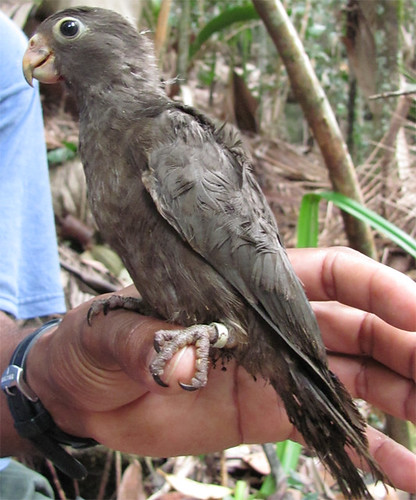100 Black parrots ringed
 Monday, March 19, 2012 at 14:24
Monday, March 19, 2012 at 14:24  Praslin Black parrot nestling with newly fitted leg bandResearchers studying the Black parrot reached a significant milestone in their work to learn more about the national bird when they attached leg rings to the one-hundredth Black parrot last week.
Praslin Black parrot nestling with newly fitted leg bandResearchers studying the Black parrot reached a significant milestone in their work to learn more about the national bird when they attached leg rings to the one-hundredth Black parrot last week.
The small, multi-coloured rings are attached to the parrots’ legs to help researchers identify individual birds and use the information to track their feeding, nesting and breeding patterns.
The research project, being conducted by the Seychelles Islands Foundation (SIF), was started in 2008 and is intended to give environmentalists a greater understanding of the ecology of the Black parrot for purposes of better conservation management.
Team Leader, Anna Reuleaux, and her team of SIF staff, use fine nets to catch the birds in order to attach the rings, and use internationally recognised best practices to ensure that the birds are not harmed in any way.
While Black parrots are seen across Praslin, an earlier phase of the project investigated abundance and monitored their feeding habits, and established that they are mostly found in the Praslin National Park and favour the seeds and fruits of Praslin’s endemic palm forests.
Recent population survey results are about to be published in the international conservation journal Oryx and indicate that there are 520–900 parrots on Praslin.
The project is also designed to gain a better understanding of the potential threats to the Black parrot. One of the primary concerns of local conservationists is the continued presence on Mahé of the introduced Ring-necked parakeet.
This highly adaptable bird is already an agricultural pest on Mahé and possible source of avian diseases.
Environmentalists fear that if it should reach Praslin its effect on the native Black parrot population could be disastrous.
“The Ring-necked parakeets were introduced to Mahé nearly 20 years ago and we have been incredibly lucky that so far they have not established on Praslin.
The government has been conducting an eradication programme for the last 10 years but their numbers are now increasing and if action is not taken it is only a matter of time before they reach Praslin where the consequences for the Black parrots could be devastating,” said SIF science coordinator Dr Nancy Bunbury.
To counter the threat posed by the Ring-necked parakeets, SIF is implementing a European Union funded project to eradicate the birds from Mahé before they make the short flight to Praslin.
“The Ring-necked parakeets are not native to Seychelles and are only here because people have introduced them. They are native to Asia and mainland Africa and have been introduced to 39 other countries.
The Black parrot research project is expected to continue for a minimum of 12 more months.

